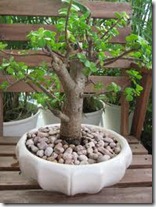 During the autumn outdoor trees start preparing for the coming winter by hardening up new growth and (for deciduous trees at least) dropping leaves to reduce moisture loss
During the autumn outdoor trees start preparing for the coming winter by hardening up new growth and (for deciduous trees at least) dropping leaves to reduce moisture loss
During overwintering trees enter a period of dormancy, which is important for Bonsai trees to follow as well, so don’t overprotect them by placing them inside; (sub)tropical trees are an exception and should be placed indoors during the winter.
In nature trees are often subjected to temperatures of minus 10 degrees Celsius (14 °F) and lower. The tree’s roots however are too deep under the ground to freeze. Therefore, as long as the root-system of most Bonsai trees is protected, low temperatures are not a serious problem as the foliage protects it selves when it enters the period of dormancy.
Keeping your trees in a greenhouse or cold frame during the winter is recommended for those living in cold areas, as roots in the shallow pots easily freeze. When such accommodation is not available, use covers around the pots to prevent your Bonsai. When living in warm, (sub)tropical environments you can normally leave your trees unprotected.
When in dormancy, be careful not to expose your trees to an extended period of high temperatures (open greenhouses when they warm up during sunny days for example) as this might bring them out of dormancy. Once it gets cold again the trees don’t have their natural protection and buds die off.
When overwintering, keep a close eye on your trees. Water when the soil dries out, the trees don’t absorb much water when in dormancy so be careful not to water too often either. Also check your trees for insects or infections regularly. During the spring you can place your trees outside again, but be wary to protect new growth against late frosts.

Deprecated: strpos(): Passing null to parameter #1 ($haystack) of type string is deprecated in /home/agriviek8Qv/agriviet.net/public_html/wp-includes/comment-template.php on line 2522